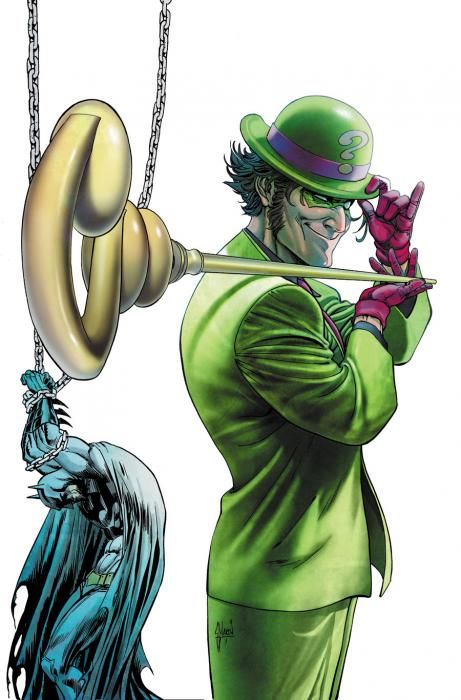"Batman" #23.2 by Scott Snyder, Ray Fawkes and Jeremy Haun offers something that many of its fellow DC Comics titles have not over the past two weeks: a legitimate tie-in to the company's ongoing "Forever Evil" event. The villain spotlighted in this issue is Edward Nygma, aka The Riddler, who stalks the darkened and chaotic halls of Wayne Enterprises in the wake of the bedlam ushered in by the bad guys in "Forever Evil" #1, and this well-paced and insightful standalone issue serves its purpose by giving readers a detailed look at the character in DC's New 52 era.
Snyder has already given readers a peek at the early days of The Riddler in "Zero Year," which has been paused for one month to make way for this and the other "Villains Month" issues. But it's actually a well-timed break that momentarily brings the timeframe of the title back to the present and allows for exploration of Nygma's modern-day personality, nicely coinciding with the character's recent "Zero Year" appearance. It's a pleasant change of pace from many of the other Villains Month issues that feature origin stories, as elements of The Riddler's origin have already been touched upon in "Zero Year," so Snyder and Fawkes are free to focus instead on a contemporary Riddler, whose character in its latest incarnation had yet to be fully studied.
If any of Batman's rogues' gallery was ripe for reinterpretation, it was The Riddler, whose prior one-dimensional, gimmicky nature was a challenge for many writers who, if able to even take the character seriously, struggled to use the character in a workable story. Gone is the wacky, quirky stand-up villain whose lines all seemed to come from an old box of Dixie Cups to a suave, calculating and disturbed individual whose cold, low-key and methodical demeanor makes him far more threatening. Snyder and Fawkes afflicting the character with haphephobia (fear/dislike of being touched) is an additional clever touch that's oddly fitting, and makes The Riddler a villain that everyone literally wants to stay away from. This isn't the first time the character has been reinvented, but these changes feel natural and gentle enough to have staying power; the writers have instilled enough unique traits to finally give The Riddler the feel of a well-developed and believable character.
Characterization aside, Snyder, Fawkes and Haun do an excellent job of constructing the story. Starting off with a mere half-page, three-panel flashback of The Riddler's days of being brutalized while committed at Arkham Asylum, the motive for his subsequent and audacious break-in to Wayne Enterprises is immediately established, although this motive is cleverly hidden behind a false one that easily presumed. For the remaining 19.5 pages, Nygma's calm but brazen journey through the building is filled a pervasive sense of tension, as his cool manner of conduct belies the chaos he creates and the vengeance he seeks.
The entirety of the issue is tightly narrated, as Nygma's riddles are laid out early on and then solved one by one as he approaches his goal, all with genuine surprises that often are shocking. Haun keeps everything flowing at a brisk pace, rarely using more than six panels per page and not filling these panels with any more detail than necessary. His lighter touch keeps this dark-themed story from seeming gloomy or depressing, and the chemistry between Snyder's plot, Fawkes' script and Haun's art makes for a beautifully taut and satisfying single issue story.
"Batman" #23.2 is a skillfully-built tale that is exemplary of what a standalone comic book story can and should be, all the while playing its part in a larger storyline. Halfway into Villains Month, this so far is one of the best tie-ins to come out of it.

